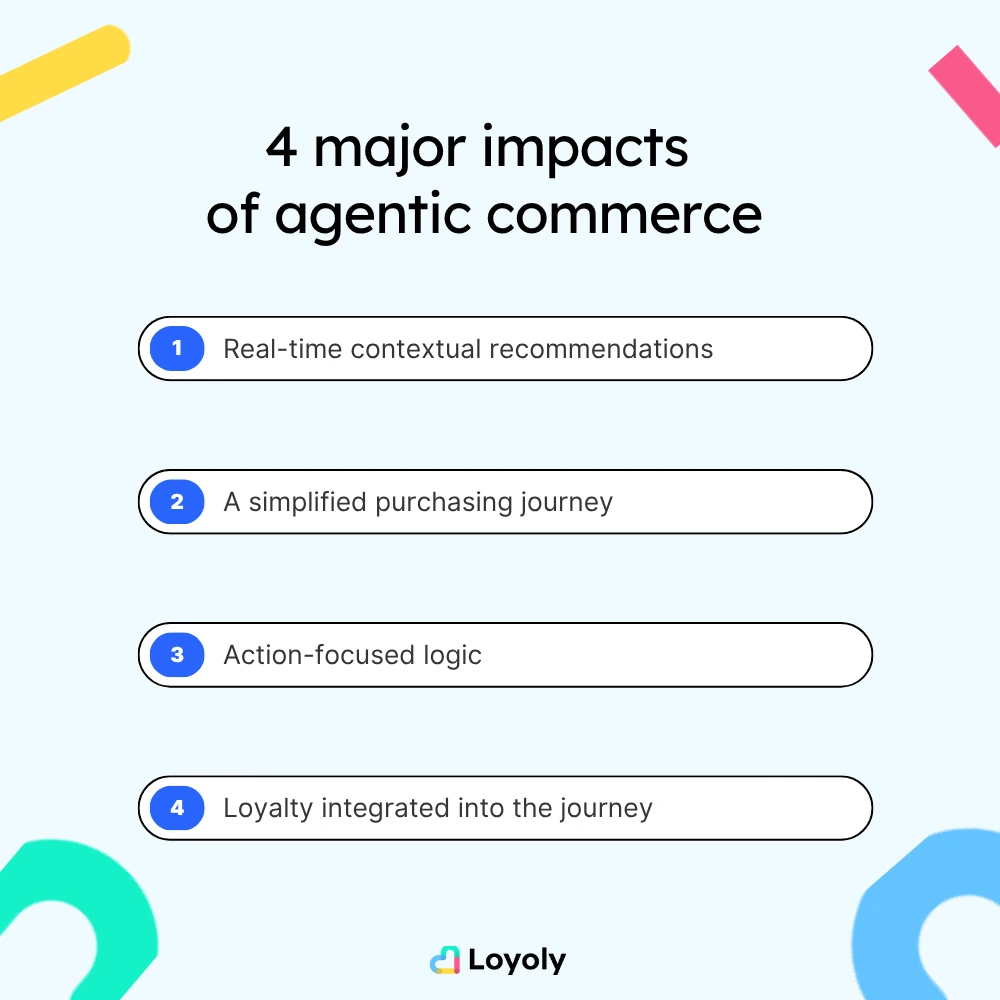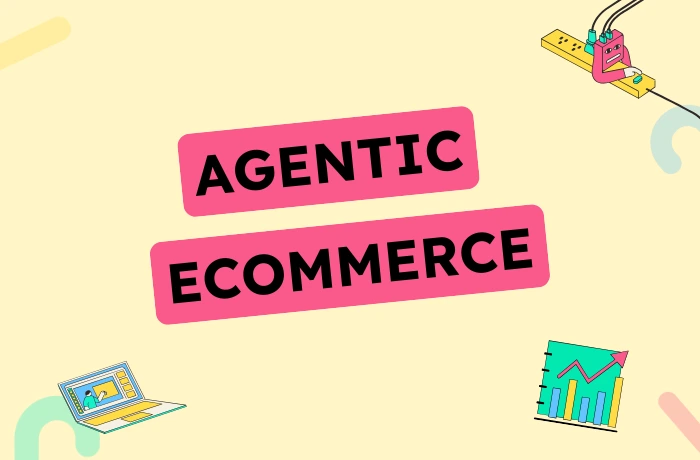Agentic commerce.
It's a term that's been making waves in e-commerce.
At first glance, it looks like just another tech trend.
But when you dig a little deeper, you discover a real promise: the promise of redefining the way consumers interact with brands.
And we're not just talking about another sales channel.
We're talking about a personalized, seamless, user-driven journey that can span all platforms.
So, is it a real revolution or just a well-marketed buzzword?
Let's dive into this concept to get a clearer picture and see how it can be used in e-commerce.
What is agentic commerce?
Agentic commerce is a new approach to e-commerce where purchasing is delegated... to AI.
Yes, really.
In this model, it is no longer the user who browses a website or opens an app to make a purchase. Instead, an intelligent, autonomous agent or agents act on their behalf.
The word “agentic” comes from “agency,” in other words, the ability of a system to make decisions on its own.
We are no longer talking about simple purchasing assistance, but about autonomous initiative.
AI analyzes needs, explores options, compares, decides, and sometimes... buys, without human intervention.
A seamless, proactive shopping experience, available everywhere.
There's no need to go to a specific website; the agent acts where it's relevant, whether that's in a search engine, a messaging app, or a voice assistant.
How is it different from conversational or predictive commerce?
Be careful not to confuse the two.
Agentic commerce goes much further than conversational or predictive commerce.
Conversational commerce is when you interact with a chatbot or advisor via WhatsApp or Messenger.
Predictive commerce, on the other hand, offers you products based on your history or that of similar profiles.
In both cases, humans remain at the heart of the decision.
AI guides and suggests, but does not decide.
In agentic commerce, AI acts alone.
It has enough context, data, and rules to take action independently.
It knows what you like, your constraints, and your favorite brands.
And it can order for you. Yes, really.
It's this decision-making autonomy that changes everything.
It transforms AI into a proactive buyer, not just a chatty assistant.
Why all the hype around agentic commerce?
Agentic commerce is shaking up the traditional e-commerce model.
Tech giants are jumping on board one after the other, and for good reason.
Google's announcement and the example of Agentic Checkout
Google kicked things off with its Agentic Checkout project.
The idea is that AI is capable of completing an online purchase for you, in one click, from your mobile phone.
All the user has to do is express an intention: “I want this T-shirt in size M” and the agent takes care of the rest.
Searching, selecting, adding to the cart, paying... all without opening a single app.
In terms of the customer experience, the change is significant.
Less friction, fewer clicks, more “instantaneity.”
The buyer is no longer constrained by a rigid conversion funnel. They delegate, and AI executes.
This is no longer a simple UX improvement.
We are moving towards a highly streamlined purchasing process, integrated directly into the user's environment (search engine, voice assistant, etc.).
The growing involvement of other tech giants
Google is not alone in this niche.
Amazon, Meta, Shopify... all are exploring more or less advanced forms of autonomous AI for commerce.
At Amazon, Alexa continues to gain decision-making capabilities.
Meta, for its part, is investing heavily in generative AI to better capture purchase intent on its platforms.
And Shopify is already experimenting with assistants based on customer history to automate recommendations... and even orders.
What is at stake in this race?
To become the most effective AI assistant for converting, without ever leaving the brand's ecosystem.
And at the heart of it all, omnichannel is becoming increasingly important, but it is not a new concept.
The boundaries between channels are blurring.
The customer, or rather their agent, can move from one platform to another without interruption.
👉 To explore the topic of omnichannel further, we recommend this article: Omnichannel in e-commerce.
4 major impacts of agentic commerce on the customer experience
Agentic commerce is not just changing the tools, it is transforming the entire logic of the customer journey.

1. Real-time contextual recommendations
AI is no longer content with suggestions based on history.
It interprets intentions in real time, according to the context.
This results in personalized recommendations that evolve as the exchange progresses.
👉 Read about the importance of personalization in eCommerce
2. A simplified purchasing journey
The user enters their preferences once.
Then AI manages everything:
- selection
- comparison
- purchase
The journey becomes invisible.
And that changes everything.
3. Action-focused logic
Here, AI isn't there to chat.
It's there to convert.
Fewer steps, less hesitation.
The purchase funnel is compressed, almost erased.
👉 To understand this, you need to know the customer journey in detail. Help yourself with our article on the 5 stages of the customer journey.
4. Loyalty integrated into the journey
By automating the purchase, the agent can also integrate reward mechanisms: accumulated points, personalized offers, exclusive benefits.
It is loyalty that is activated over the course of orders.
This is a real lever for long-term engagement.
This is exactly what our loyalty solutions offer.
The goal is to integrate loyalty where it is most natural, in the customer journey.
Pssst... You might find this interesting!
Loyalty programs are strategic for your brand, and we can probably help. Check out our platform!
3 questions to ask yourself as an e-merchant
Before diving into agent-based commerce, a few questions are worth asking.
This is to avoid confusing innovation with haste.
1. Are you ready to let AI speak on behalf of your customers?
Delegating purchasing is powerful.
But it also means letting AI represent your customers when they interact with your brand.
Is your brand voice clear enough to be understood (and respected) by a machine?
Does your customer journey support automated decision-making?
In short, are you ready to give up a little control to gain efficiency?
The consistency of your brand image depends on it, as does your differentiation.
2. Is your loyalty strategy compatible with agentic commerce?
If tomorrow an AI agent makes a purchase for your customer, how will you continue to retain their loyalty?
Programs need to adapt.
Think in terms of dynamic rewards, personalized missions, and objectives that can be activated even without human intervention.
No need to revolutionize everything right away.
But you can already integrate steps into your engagement journey.
Start by activating your post-purchase customers, then introduce automatic reward logic.
3. Do you have the right data and tools?
Agentic commerce relies on a foundation of good data that belongs to you (first-party data) or to third parties.
Without reliable data, AI cannot be autonomous.
CRM, CDP, engagement platforms... everything must be well connected and well utilized.
Solutions such as Loyoly are capable of centralizing, segmenting, and activating customer data.
Loyoly for engaging customers in an agentic world
Purchasing behaviors are becoming automated.
Expectations are accelerating, and many brands are struggling to keep up.
But not everything needs to be reinvented.
Often, all you need to do is activate what you already have at the right time, in the right channel.
With Loyoly, you can integrate gamified engagement mechanics: referrals, missions, rewards.
Post-purchase activation becomes intelligent, personalized, and scalable.
Contact our team and discover how Loyoly can adapt to your reality and your strategy.

.png)









.png)
.png)
.png)
.png)
.png)